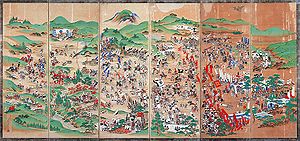Rupert, Count Palatine of the Rhine, Duke of Bavaria (German:
Ruprecht Pfalzgraf bei Rhein, Herzog von Bayern), commonly called
Prince Rupert of the Rhine, (
17 December 1619 –
19 November 1682), soldier, inventor and amateur artist in
mezzotint, was a younger son of
Frederick V, Elector Palatine and
Elizabeth Stuart, and the nephew of King
Charles I of England, who created him
Duke of Cumberland and
Earl of Holderness.
Prince Rupert had a very varied career. He was a soldier from a young age, fighting against Spain in the Netherlands and the Holy Roman Empire in Germany. Aged 23, he was appointed commander of the Royalist cavalry during the
English Civil War. He surrendered after the
Battle of Naseby and was banished from the British Isles. He spent some time in Royalist forces in exile, first on land then as at sea. He then became a
buccaneer in the Caribbean. Following the restoration, Rupert returned to England, becoming a naval commander, inventor, artist and first Governor of the
Hudson's Bay Company. Prince Rupert died in England in
1682, aged 62.
Career During the Civil War For some time after this Rupert commanded the troops formed of English exiles in the French army, and received a wound at Marshal
de Gassion's siege of
La Bassée in 1647. Then, following a degree of reconciliation with Charles, he obtained command of a Royalist fleet. A long and unprofitable naval campaign followed, which extended from
Kinsale to
Lisbon and from
Toulon to
Cape Verde. However, following a naval defeat by
Admiral Robert Blake, Rupert took refuge in the
West Indies. There he followed the life of a
buccaneer, preying on
English shipping. It was during this time period that his beloved brother Maurice, who captained one of the ships in Rupert's small flotilla, was killed. But the prince again quarrelled with the Royalist advisers, and spent six obscure years (1654 to 1660) in Germany and the Netherlands, vainly attempting (as also before and afterwards) to obtain his rightful
apanage as a younger son from his brother
Charles I Louis, Elector Palatine.
After the Civil War Following the
Restoration of the monarchy under
Charles II, Rupert returned to the service of England, accepting an annuity and becoming a member of the
privy council. He never again fought on land, but, turning admiral like Blake and
Monk, he bore a brilliant part in the
Second Anglo-Dutch War as actual supreme commander of the British fleet from June
1666, gaining a victory in the
St James's Day Battle. His efforts in the
Third Anglo-Dutch War met with humiliating failure (
Battles of Schooneveld,
Battle of Texel).
At some point Rupert, a talented amateur artist, had learned of the printmaking process of
mezzotint invented in 1642 by
Ludwig von Siegen, a German Lieutenant-Colonel who was also an amateur artist. Whether the two ever met is a subject of scholarly controversy, but Siegen had worked as chamberlain, and probably part-tutor, to Rupert's young cousin William VI,
Landgrave of
Hesse-Cassel, with whom Rupert discussed the technique in letters from 1654.
Rupert produced a few stylish prints in the technique, mostly copies of paintings, and introduced it to England after the Restoration. He was wrongly credited by
John Evelyn as its inventor in 1662. However Rupert appears to have invented, or perfected, the "rocker", a key tool in the process. It was Wallerant Vaillant, Rupert's artistic assistant or tutor, who first popularised the process and exploited it commercially.
In 1670, Rupert became the first Governor of the
Hudson's Bay Company, after having sponsored an expedition of
Radisson and
des Groseilliers into Hudson Bay. The HBC was granted a trading
monopoly in the whole Hudson Bay watershed area, an immense territory named
Rupert's Land. In 1869, control of this territory reverted to the British and Canadian governments..
In retirement he continued to hold important governmental posts; from
1673, when he was 54, to
1679, he served as England's
Lord High Admiral. He did not marry but lived in the 1670s with a
Drury Lane actress named
Peg Hughes and had a daughter by her, named Ruperta. Ruperta married
Emanuel Scrope Howe, (1663-1709), brother of 1st
Viscount Howe (
1648-
1713), and had five children, Sophia, William, Emanuel, James and Henrietta.
Prince Rupert died at his house in Spring Gardens,
Westminster, on
19 November 1682, and was buried in
Westminster Abbey.
Prince Rupert, British Columbia and the
Rupert River in Quebec are named after him.
Career Following the Restoration Ancestors Prince Rupert is the protagonist of
Poul Anderson's
alternate history/
fantasy book "A Midsummer Tempest" - where the Prince, with the help of various
Shakespearean characters who are actual persons in this timeline, eventually defeats
Cromwell and wins the
English Civil War.
 Notes Virtual Vault
Notes Virtual Vault, an online exhibition of Canadiana at Library and Archives Canada


 Geography
Geography
 Spacecraft and subsystems
Spacecraft and subsystems


 Windows Defender
Windows Defender
 Participation
Participation Graphical processing units
Graphical processing units New Jersey political career
New Jersey political career


 Notes
Notes